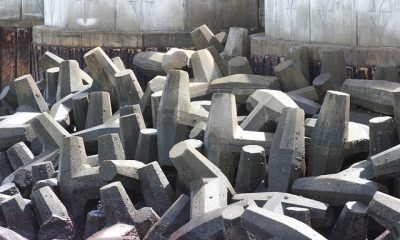Tech
Organizing Your Server Room: The Benefits Of Rack Shelves

Efficient server room management is crucial for businesses and organizations to maintain optimal system performance, security, and reliability. One of the key elements of effective server room organization is the use of rack shelves. Rack shelves are equipment that can be attached to racks or cabinets to hold servers, switches, routers, and other networking devices.
In this article, we will explore the benefits of using rack shelves in organizing your server room. We will discuss how rack shelves can help maximize space utilization, improve airflow and cooling efficiency, streamline troubleshooting and updates processes, as well as enhance overall system performance and efficiency. By understanding these advantages of rack shelves, you can make informed decisions about designing a functional and organized server room that meets your business needs.
Maximizing Space with Rack Shelves
The utilization of rack shelves creates an efficient use of vertical space within a designated area for server equipment storage. Rack shelves provide adjustable options that allow for the customization of shelving units to fit specific equipment dimensions and requirements. This feature ensures that all the server components are fitted securely in place, which helps to minimize any disruptions or damage caused by equipment movement.
Moreover, the incorporation of cable management features on rack shelves promotes proper organization and enhances cable routing efficiency. The use of multiple cables and wires can lead to clutter, making it difficult for technicians to identify and manage them effectively. However, with rack shelves’ built-in cable management systems, these issues can be resolved quickly. The result is a neatly arranged storage system that saves time during maintenance procedures and reduces any potential risks associated with tangled cables. Ultimately, maximizing space with rack shelves not only increases storage capacity but also improves overall functionality while reducing operational costs.
Improving Airflow and Cooling
Maximizing airflow and improving cooling in data center environments is of utmost importance to prevent equipment overheating, system failures, and costly downtime. One effective way to achieve this is by using rack shelves for equipment placement. Rack shelves help ensure that the equipment is properly spaced out, preventing any hotspots from forming. This spacing allows cool air to flow more freely around the equipment, which helps maintain optimal operating temperatures.
Another benefit of using rack shelves is that they facilitate cable management. When cables are neatly organized on shelves, with proper labeling and documentation, it becomes easier to identify which cables go where during maintenance or troubleshooting. Proper cable management also ensures that cables do not obstruct airflow or become a tripping hazard in the server room. Overall, maximizing airflow and improving cooling through the use of rack shelves can help prolong the life of your equipment while minimizing downtime due to overheating or system failures.
Streamlining Troubleshooting and Updates
Efficient and streamlined troubleshooting and updating processes are critical in maintaining a well-functioning data center, as the ability to quickly diagnose and resolve any issues can help prevent costly downtime and minimize disruptions to operations. Rack shelves can play a significant role in ensuring that these processes are carried out with precision. With servers organized on rack shelves, technicians have clear visibility of all equipment, making it easier to identify problem areas and troubleshoot effectively.
Moreover, remote access can be facilitated by neatly organizing servers using rack shelves. This allows for easy access to equipment from any location without having to be physically present in the server room. Furthermore, labeling systems can significantly streamline troubleshooting processes by providing clear identification of each server’s function or purpose. In conclusion, it is essential to invest in quality rack shelves as they offer an array of benefits that contribute towards efficient troubleshooting and updating processes within a data center setting.
Enhancing System Performance and Efficiency
Improving system performance and efficiency is a critical component of data center management, and the use of well-designed equipment can play a significant role in achieving this goal. One way to enhance system performance is by reducing clutter in the server room. The use of rack shelves can help organize servers, switches, and storage devices, making it easier to manage cables, power cords, and network connections. This not only reduces the risk of tripping hazards but also allows for better airflow through the server room. When there is proper ventilation in place, equipment will operate at optimal temperatures, reducing the risk of overheating that could lead to downtime or hardware failure.
Another benefit of using rack shelves is improving cable management within the server room. When cables are properly organized and labeled with their corresponding ports on each device, it makes it easier to troubleshoot issues when they arise. This saves time during maintenance or updates since technicians can easily identify which cable needs attention instead of tracing wires from one end to another. Proper cable management also prevents accidental disconnections or damage caused by accidental tugging or pulling on cables during hardware installations or removals. Overall, enhancing system performance and efficiency through organized equipment placement and cable management not only improves uptime but also prolongs the life span of hardware components while minimizing unnecessary downtime due to human errors.
Frequently Asked Questions
What is the weight capacity of rack shelves?
Rack shelf durability is an important factor to consider when choosing the appropriate shelving for your server room. The weight capacity of rack shelves can vary depending on the manufacturer, materials used, and construction design. To ensure optimal weight distribution on rack shelves, it is crucial to consider the overall weight of your equipment and distribute it evenly across multiple shelves instead of overloading a single shelf. Additionally, it is recommended to regularly inspect and maintain your rack shelves to ensure their structural integrity and prevent any potential damage or failure that may result in costly downtime or data loss.
Can rack shelves be customized to fit specific equipment dimensions?
Customization options for rack shelves allow for flexibility in fitting specific equipment dimensions. The installation process is typically straightforward, with various mounting options available to accommodate different equipment sizes and weights. In selecting customized rack shelves, it is important to consider the weight capacity and compatibility with existing equipment. Additionally, customization may involve additional costs and lead time for manufacturing and delivery. However, these considerations can be outweighed by the benefits of a tailored solution that maximizes space utilization and improves accessibility of equipment in the server room.
How do you properly secure equipment to rack shelves to prevent damage or accidents?
Proper installation and cable management are essential components of securing equipment to rack shelves to prevent damage or accidents. The use of symbolism can help convey the importance of this process, as a chain is only as strong as its weakest link. Similarly, improperly secured equipment on a rack shelf can compromise the entire system’s safety and integrity. To avoid this situation, it is crucial to follow manufacturer guidelines when mounting devices and ensure that all screws or bolts are tightened properly. Additionally, utilizing cable management tools such as zip ties or Velcro straps can help organize cords and prevent them from becoming tangled or damaged. By taking these steps, one can ensure that their server room remains secure and functional for years to come.
Are there any maintenance requirements for rack shelves?
Cleaning procedures and shelf lifespan are important considerations when maintaining rack shelves. Dust, debris, and other particles can accumulate on the shelves over time, which can obstruct airflow and cause overheating of the equipment. To prevent this from happening, it is essential to establish a regular cleaning schedule for the rack shelves. This involves removing all equipment from the shelves and wiping them down with a damp cloth or using compressed air to blow away any dust or debris that may have accumulated in hard-to-reach areas. Additionally, it is important to periodically inspect the shelf structure for signs of wear and tear such as rust or corrosion that can compromise their stability and longevity. Replacing worn-out shelves before they fail ensures that your server room remains safe and functional at all times.
Can rack shelves be used for non-server equipment, such as networking equipment or audio/video equipment?
Rack shelves can be used for more than just server equipment – they are also useful for storing networking solutions and audio equipment. By utilizing rack shelves, organizations can better organize their equipment while also saving space. Networking devices such as switches, routers, and modems can all be stored on rack shelves to keep them organized and easily accessible. Audio equipment such as amplifiers, mixers, and speakers can also benefit from being stored on rack shelves to prevent damage and make setup easier. Overall, using rack shelves for non-server equipment is a practical solution that can lead to a more efficient and organized workspace.
Conclusion
In conclusion, the implementation of rack shelves in your server room has a multitude of benefits that cannot be ignored. From maximizing space and improving airflow to streamlining troubleshooting and enhancing system performance, these simple additions can drastically improve the overall efficiency and productivity of your infrastructure.
On one hand, rack shelves allow for better organization and utilization of available space, resulting in a more streamlined and efficient setup. On the other hand, they also provide improved cooling capabilities by allowing for proper airflow throughout the servers. Additionally, with easy access to all components through clear labeling and organization on racks, troubleshooting becomes less time-consuming and complicated. Finally, optimizing system performance through enhanced cooling capabilities translates into increased efficiency that ultimately leads to cost savings for businesses.
Therefore, investing in rack shelves is not only practical but also a wise decision for any business looking to optimize their server room operations. By taking advantage of these benefits, companies can ensure that their infrastructure remains reliable and efficient while minimizing downtime due to equipment failure or inefficiencies. In essence, rack shelves are an investment that pays dividends both immediately as well as over the long term.





















































